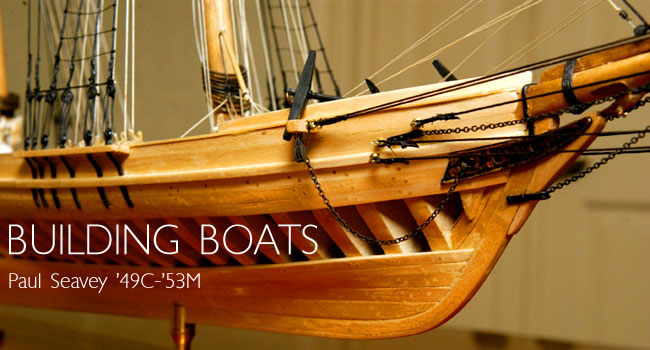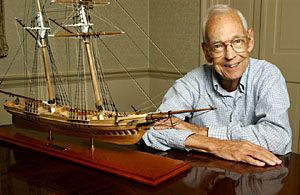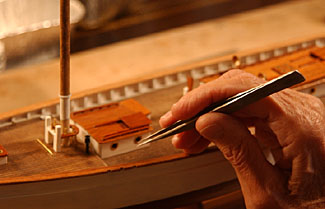
|
After nearly half a century as an Emory doctor and faculty member, Paul Seavey ’49C-’53M might have found retirement a little dull. But soon after he stopped working in 1997, he took up a new interest that blossomed into a hobby, then a passion: boats. “I have always loved sailing,” Seavey says. “My father put me in a dinghy when I was eight years old.” The family lived in Clearwater, Florida, where Seavey spent a good deal of time on boats, as well as during their regular summer vacations in Maine. He also sailed in the Navy on the USS Destroyer. Cancer prevents Seavey from sailing regularly now. Instead, he has taught himself to build model ships by hand, starting with just the boat plans and raw materials. His boats are not built from kits, but from scratch, like making cookies starting with flour and butter rather than refrigerated dough. “I needed to do something with my hands,” he says. “It was difficult to learn. I didn’t know anything about it.” Over the past few years Seavey has not only completed four models but also has devoured stacks of books and information both about model-building and the history of the famous ships he builds. “I’ve read every book I could find on the sailing ships of our country,” he says. “I think there is real value in what I have learned from a historical standpoint.” Seavey’s first model was a Gloucester Fisherman, a sleek, trim, solid-hull model with a black bottom. Then he built the famous USS Constitution, a Navy ship built in 1797, after visiting the actual boat in Boston and taking more than a hundred pictures to make sure he got every detail right. “It’s a beautiful ship,” he says, “and a really pretty model.” Next, Seavey decided to try “planking,” the time-consuming process of making and placing each plank of the boat’s hull and deck, rather than constructing them out of solid pieces of wood. The planks have to be soaked or boiled so that they will bend properly. Using this method, Seavey assembled the America, the first boat to win the America’s Cup. Then he made a topsail schooner–“The epitome of a sailing ship, there was no better ever built,” according to Seavey–the Jefferson Davis, built in 1853. Now Seavey is nearly finished with a model of the Bowdoin, a schooner built in 1921 at a Maine boatyard and used by the Arctic explorer Donald Macmillan for nearly thirty voyages. The real Bowdoin is part of the Maritime Academy of Maine and is still sailing. Each of Seavey’s models is authentically outfitted down to the last detail, with every sail rigged just as it would be at sea. He makes most of the tiny wooden parts himself; some of the metal pieces he buys from the company in Maine where he gets his plans and materials. “The rigging is absolutely perfect, according to the plans,” Seavey says. “I’ve sailed, so I knew most of this already, but I’ve learned every single part of these ships.” One ship required that Seavey make a round cockpit. “I broke three before I got that to work,” he says, chuckling. “But that’s the fun. I love the little details.” Seavey was an Emory professor of medicine and an internist who treated the last three University presidents in addition to many other prominent Emory community members and families. He completed his residency in internal medicine at Duke Medical Center and a fellowship in cardiology under Emory physicians Bruce Logue and J. Willis Hurst. After a decade in private practice, he returned to Emory in 1967 as a faculty member in the department of medicine and as a member of the Emory Clinic. For ten years he served as chief of internal medicine. Gratitude has prompted several of Seavey’s patients–most prominently philanthropists John Lupton, Bill Robinson, and several members of the Rollins family–to make gifts to the School of Medicine in his honor to establish the Paul W. Seavey Chair in Internal Medicine and the Paul W. Seavey Medical Endowment. The latter, worth more than $3 million, funds fellowships and supports the activities of young faculty in internal medicine at the beginning of their careers. Although Seavey was the first in his family to attend Emory, each of his three daughters graduated from the University, as did all their husbands. Two of his grandchildren have graduated from Emory as well. Sailing ships may be Seavey’s passion, but medicine is his first love. “I’m really a doctor at heart,” he says. “I love medicine. Emory was good to me.”–P.P.P.
|
 |
